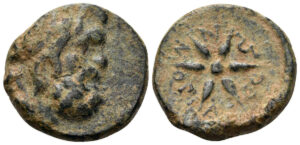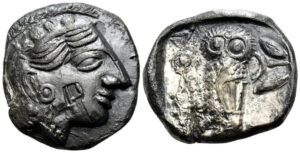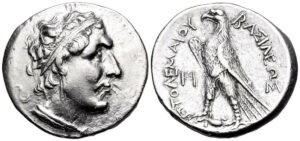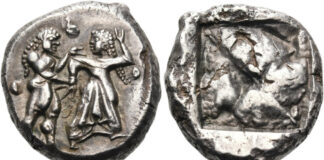Ancient Rarities at Obolos 21
Let’s turn to Obolos 21, which will be closing on 2nd January 2022. The sale contains 1,157 lots from all over the ancient world, as well as medieval and some early modern too. As we always say, there is something for everyone in this auction!
There is a novelty item that used to be found in seaside resorts in England, and in many places in the US, which was bought as a souvenir, generally for Mothers and Grandmothers: a tea cup made to be only a half, with a humorous inscription, “You asked for half a cup!” The presentation of such an item usually resulted in the lady recipient smiling sweetly and locking her father/husband/son in the basement for the rest of the day!
- Unlike halved tea cups, halved coins were made to provide small change, and here is a good example, lot 78 (Starting Price: 200 CHF): This is the remains of a Siculo-Punic tetradrachm, struck in an uncertain mint in Sicily during the 2nd half of the 4th century BC. It was cut in half with a chisel and countermarked with a somewhat clumsy wheel of four spokes. There is undoubtedly a very interesting story behind this, but what it is, well, its new owner will an exciting time trying to discover it!

It is always exciting to come across a coin from a hitherto unknown mint! That is the case with lot 143 (Starting Price: 200 CHF), a bronze of the Moriaseis, a tribal group in the Thraco-Macedonian area. The first known example of a coin in the name of this group was published by the late Professor P. R. Franke (1926-2018) in 2008, from an example then in his collection. For those who did not know him, Professor Franke was a very important German professor of Classical archaeology, and a well-known numismatic scholar (much of his private collection of Ancient Greek coins, primarily acquired during his long visits to Greece, is now in Yale). He also was quite a character: he appeared at the International Numismatic Congress of 1973 (in New York and Washington) wearing a white summer suit, white shoes and looking remarkably elegant. When I met him (I was then a lowly graduate student), he was strolling around Audubon Terrace during the lunch break, pontificating and surrounded by admiring European academics. Unfortunately for him, he made the mistake of being rather haughty with the late Charles Hersh (in those days he was rather haughty with almost everyone, but being haughty with Charles was not to be recommended…). And so Charles, when informed that PRF was teaching at Saarbrücken, immediately said that he had some nice photographs of that city and would PRF like to see them. Franke said yes. So Charles said he would bring them in the next day. And so he did. What PRF did not know was that Charles was the navigator on a B-29 bomber during World War II and the photographs were from his plane’s nose camera. Apparently, this was one of the few times in PRF’s life that he was at a loss for words! – But getting back to Moriaseis (there is apparently a new study on these issues by M.-G. Parissaki and Y. Stoyas in the proceedings of 13th International Congress of Thracology 2017, but it is, alas, not yet published), this piece is one of less than a dozen known examples, and just goes to show how there is always something new in ancient numismatics!
- One of the problems about ancient Greek bronze coins is that they were made to be used for daily needs, and, thus, circulated far more widely and more frequently than more highly valued silver and gold issues. As a result it is very difficult, indeed, to find truly top quality Greek bronzes (in addition, they are far more subject to damaging corrosion than are silver or gold coins). So here is lot 230 (Starting Price: 75 CHF), a bronze hemiobol of Alexander struck in Tarsos, c. 327-323 BC – can you imagine ever finding a better example??
- How about this for a gift to the chicken-fancier in your life? It is lot 432 (Starting Price: 50 CHF) bearing a dignified head of a distinguished rooster. It’s apparently an obol from Dardanos in the Troad and is basically unpublished.
- Here’s another coin from the Troad, this time from Lamponeia (lot 437, Starting Price: 75). It is an obol on the Lesbian standard (as Traité II, 2, 2295) and has as its type a head of Dionysos and a facing bull’s head; the quality of die engraving is simply outstanding in every way.

- Moving from splendid Classical style we now have another kind of style: odd style! What the following coin shows is how an engraver working far from the Greek world used Greek designs. He surely had seen Athenian tetradrachms, perhaps even had one as a model, but he certainly made the design his own! This is a tetradrachm that was surely produced in northwestern Arabia, in the ancient kingdom of Lihyan (lot 583, Starting Price: 500 CHF). The obverse is the usual head of Athena, with a typical countermark, but the reverse really does change the standard type, which, as everyone knows, has an owl standing to the right. While sadly damaged by corrosion, we have an owl with a body to left but a head fully facing front (at first glance the whole owl might be facing but what we can see, despite the damages, makes this unlikely); the usual legend ΑΘΕ to the left; and the olive sprig and prominent crescent on the right. As far as we can tell this intriguing coin is unique.

- The mainstream Ptolemaic silver tetradrachm coinage is in some ways rather monotonous because almost all of it bears a portrait of the dynasty’s deified found, Ptolemy I. But since the quality of those representations is so varied there is, paradoxically, a great deal of variety within that monotony! And considering that many of the Ptolemies, especially the earlier ones, shared a strong family resemblance with each other, the occasional actual portrait has a habit of lurking, often unrecognized, among the mass. But what are we to do with this one (lot 635, Starting Price: 200 CHF)? The obverse head is probably meant to be Ptolemy I, but the style is quite frankly off the charts! Lorber knew of a parallel, the mint of which she located in northwest Asia Minor: perhaps it was a short-lived naval base of Ptolemy III’s?

- Here’s the final coin of today’s Obolos 21 highlights: This is lot 670 (Starting Price: 50 CHF), an assarion in the name of Geta Caesar struck c. 205 in the minor Messenian city of Kolonides (also Kolonis or Kolone, near modern Vournaria). This coin is apparently unknown – or at least it is unpublished – and forms part of an extraordinarily abundant issue of early Severan Roman Provincial issues produced in Greece, primarily in the Peloponnesos. These coins must have been minted for reasons of state, probably to serve military needs. We can be sure of that because, unlike so many other Roman Provincial issues, these coins tend to consistently turn up far from their mints: to be exact, in southern Turkey, Syria (in the fortress city of Dura Europos, for example), Lebanon and Israel! A good reason for that was Caracalla’s planned campaign against Parthia, for which he is known to have engaged a serious number of troops from Greece (and they carried their small change with them). So this piece of early 3rd century small change must have done quite some travelling before being lost!
You can find all lots of the auction in the Obolos 21 online catalog.
For further information about Nomos AG, visit their website.




